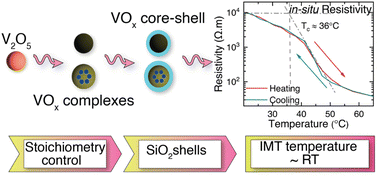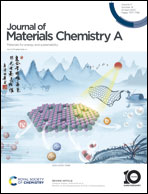Infrared modulation via near-room-temperature phase transitions of vanadium oxides & core–shell composites†
Abstract
Vanadium oxides (VOx) are highly promising materials for heat retardant coatings, enabled by their insulator-to-metal phase transition (IMT). Currently, this IMT typically occurs at 68 °C, well above room temperature. Here, we develop a dopant-free approach to lower the IMT temperature to ∼40 °C enabling near-room temperature infrared modulation, by simple, solution phase synthesis. This is achieved by both controlling the stoichiometry of the metal oxide and by using a SiO2 shell around the VOx particles, with the difference in thermal expansion coefficient between SiO2 and VOx inducing sufficient strain in the VOx to dramatically lower the IMT temperature. This approach enables the production of a functional solution of suspended VOx nanoparticles with near-room temperature IMT. The combination of near-room temperature IMT and solution phase nanoparticles dramatically increases the ease, scalability, and efficacy of VOx application.

- This article is part of the themed collection: #MyFirstJMCA


 Please wait while we load your content...
Please wait while we load your content...